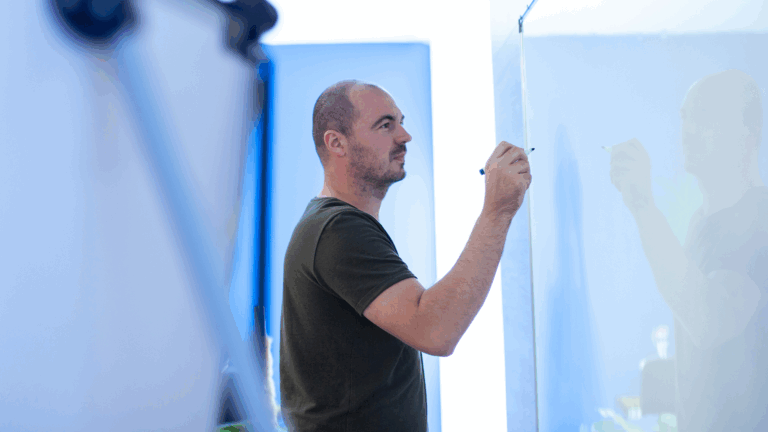 DE
DE- Industries
- Finance
Nearshore software development for finance—secure, scalable, and compliant solutions for banking, payments, and APIs.
- Retail
Retail software development services—e-commerce, POS, logistics, and AI-driven personalization from nearshore engineering teams.
- Manufacturing
Nearshore manufacturing software development—ERP systems, IoT platforms, and automation tools to optimize industrial operations.
- Finance
- What we do
- Services
- Software modernization services
- Cloud solutions
- AI – Artificial intelligence
- Idea validation & Product development services
- Digital solutions
- Integration for digital ecosystems
- A11y – Accessibility
- QA – Test development
- Technologies
- Front-end
- Back-end
- DevOps & CI/CD
- Cloud
- Mobile
- Collaboration models
- Collaboration models
Explore collaboration models customized to your specific needs: Complete nearshoring teams, Local heroes from partners with the nearshoring team, or Mixed tech teams with partners.
- Way of work
Through close collaboration with your business, we create customized solutions aligned with your specific requirements, resulting in sustainable outcomes.
- Collaboration models
- Services
- About Us
- Who we are
We are a full-service nearshoring provider for digital software products, uniquely positioned as a high-quality partner with native-speaking local experts, perfectly aligned with your business needs.
- Meet our team
ProductDock’s experienced team proficient in modern technologies and tools, boasts 15 years of successful projects, collaborating with prominent companies.
- Why nearshoring
Elevate your business efficiently with our premium full-service software development services that blend nearshore and local expertise to support you throughout your digital product journey.
- Who we are
- Our work
- Career
- Life at ProductDock
We’re all about fostering teamwork, creativity, and empowerment within our team of over 120 incredibly talented experts in modern technologies.
- Open positions
Do you enjoy working on exciting projects and feel rewarded when those efforts are successful? If so, we’d like you to join our team.
- Hiring guide
How we choose our crew members? We think of you as a member of our crew. We are happy to share our process with you!
- Rookie booth camp internship
Start your IT journey with Rookie boot camp, our paid internship program where students and graduates build skills, gain confidence, and get real-world experience.
- Life at ProductDock
- Newsroom
- News
Stay engaged with our most recent updates and releases, ensuring you are always up-to-date with the latest developments in the dynamic world of ProductDock.
- Events
Expand your expertise through networking with like-minded individuals and engaging in knowledge-sharing sessions at our upcoming events.
- News
- Blog
- Get in touch

12. Jan 2022 •8 minutes read
Pros of using drone software for agriculture
ProductDock Team
Even though initially, UAVs (unmanned aerial vehicles) or more commonly known as drones were first built and used for military purposes, like the internet, they managed to prove helpful in a couple of different industries. It was only a matter of time until they became a mainstay in agriculture as well. And as the drone market in the industry managed to reach $1.3 billion back in 2019, it looks like drones are here to stay.
As a matter of fact, the place of drones looks pretty much cemented when it comes to agriculture. Experts predict that the market for agriculture drones will reach a pretty impressive $6.52 billion by 2026, with a compound annual growth rate of 31.4%. As of now, the demand for drones is growing faster than ever as prices decrease and as the drone software specially designed for agricultural purposes becomes more sophisticated. As such, it’s only natural that we take our time and explore the key benefits of drone usage on the field to improve soil quality, yield, and simplify farming tasks altogether. Modern farming is being transformed by drone software for agriculture, delivering powerful solutions for crop monitoring, mapping, and smart spraying.
Why use drones in agriculture?
If you haven’t heard about the usage of drone technology before, you might ask, how on earth would drones be useful in agriculture? Well, to answer your question in a short, it all boils down to increased overall efficiency. Even then, there’s more to drones than that. As they gain more ground in “precision farming”, both developers and farmers find new uses to overcome new challenges and to even further increase their overall efficiency. The real game-changer lies in drone software for agriculture, which turns raw flight data into actionable insights for farmers.
The lion’s share of these benefits comes from the fact that drone usage helps reduce uncertainty and guesswork. As you may know, success in farming will depend on a myriad of different factors that will change more or less every year, and in most cases, farmers don’t even have any control over them. Things like soil and weather conditions, precipitation, temperature, market prices, etc., are all things that are hard to precisely predict, not just for farmers, but niche experts as well. In such an uncertain industry, being efficient means being flexible and being able to adjust to everything. And this flexibility in farming is always impacted by the availability of accurate information.
Here’s where drone tech can make a huge difference. Drone software enables farmers to gain access to a huge amount of data, enabling them to increase crop yields, become more cost- and time-effective and to hammer out tasks with great precision and accuracy.
And at the breathtaking pace the world is changing today, adaptation has become a crucial factor in all industries, and agriculture is no exception. Also, given that the population is growing, and weather conditions are changing at a global level, farmers need everything in their arsenal to address all emerging challenges.
Drone tech – how it works
To become fully aware of all the benefits that drones can bring in a farm’s everyday life, one must have a better understanding of how they work. When integrated with drone software for agriculture, these autonomous machines can deliver real-time crop analysis, soil data, and planting recommendations. Typically, these machines will come with a propulsion and navigation system, and will also include different sensors and cameras, GPS, equipment that enables automated flights, and programmable controllers.
When it specifically comes to the drones that are used in agriculture, the main focus is on equipping them with technology to capture more accurate info than most satellites and airplanes are capable of gathering. The main focus of Drone-based tech in agriculture is to gather and deliver information in a format that’s easy to read and understand.
All in all, it’s a fairly simple process that includes the following steps:
Indicating all flight parameters: Evaluating and outlining the surveillance area and uploading the necessary GPS info into the drone’s navigation system.
Autonomous flights: Drones will usually carry out pre-programmed flight patterns based on specific parameters and collect all the required data.
Uploading the gathered data: The drone submits the data it managed to capture during the flight and processing said data can commence.
Sending the necessary info: After the data processing has finished, every piece of info is sent to the farmers in a simplified, easily readable format. The report has all the insight that enables farmers to make better farm management decisions.
Best practices in agriculture
As we’ve said before, drone usage in agriculture is gaining more ground simply due to the fact that they are capable of delivering real-time info, and delivering it fast. On the other hand, the evolution of the software (not to mention, the ever-increasing affordability) has also managed to increase their popularity in agriculture.
As such, here are the best practices of the tech that farmers can use to improve their operations:
Soil condition estimation
Smart farming is primarily driven by data. It enables farmers to take accurate info on different soil conditions. Before the era of drone tech, farmers had to visit the land and gather samples manually. As these drones are equipped with smart sensors, they can collect and deliver the necessary data in a more precise manner, not to mention, a lot faster.
Crop planting
After the soil gets prepared for planting, drones can shoot seeds in it. Again, this is a lot faster method than relying on old planting techniques. While crop planting with drones isn’t something that’s already gone mainstream, some companies are already working on perfecting the process and trying to figure out ways to make it as efficient as possible. Using drone software for agriculture, farmers can automate seed planting and precision spraying with GPS-guided accuracy.
On the other hand, drones can help a great deal with spraying fields with fertilizers, herbicides and water. This can help reduce manual labor costs drastically, and can also help speed up and fine-tune the entire process.
Disease and pest control
Apart from playing a vital part in informing farmers about soil conditions, drones also play a vital role in helping detect infections, plant diseases and different pest problems. Based on the data the drones send, farmers can simply take action faster. Furthermore, apart from learning from certain conditions a lot faster, they can also fine-tune the amount of chemicals they need to combat infestations and other similar issues. Needless to say, these processes will also help reduce costs while they help improve overall field health.
Spraying
As mentioned above, smart farms use drones for agriculture spraying. This helps with a myriad of things. Firstly, it helps limit human contact with pesticides, herbicides, and fertilizers. Also, drones can complete tasks a lot faster than most airplanes and vehicles. Not to mention, they are also a great alternative for manual labor.
However, where drones really shine is handling spot treatment. They can easily detect infected areas with their cameras and sensors and work on them easily while leaving the healthy parts of the field out.
This can greatly increase safety, save time, and, obviously, also help to reduce costs.
Crop surveillance
Most agricultural fields are huge areas. Oftentimes, especially with outdated approaches, estimating the state of the crops is pretty much impossible. That being said, drones can be a huge aid in agriculture mapping. This way, farmers can get up-to-date info on plant health, and will be able to precisely pinpoint which crops and areas need attention. Using multispectral imaging and drone software for agriculture, farmers can quickly identify stress zones in large fields.
To estimate the state of your crops, the drone will inspect the entire field with its infrared cameras to determine light absorption rates. Thanks to the accurate, real-time data, farmers can then take the necessary steps to improve crop states in any given location.
Monitoring livestock
When it comes to livestock monitoring, drones can watch cattle on pastures, also reducing the need for human interference on horseback. Thanks to thermal sensory advancements, drones can also be used to find lost animals, detect sick or injured ones, and calculate overall numbers.
Most experts would agree that drones can do a better job when it comes to cattle surveillance than herding dogs. Livestock health and movement tracking becomes more efficient when paired with specialized drone software for agriculture.
Considerations
Before turning to drone solutions in agriculture, there are a few important things you should take into account. The steps involved aren’t necessarily complex or difficult, and knowing about them will enable you to get the most out of a drone-enhanced agritech business.
Setting up goals
Before buying a drone, you need to know what kind of operations you would like to conduct with it. Determine what processes you would use it the most and start from there.
Take a closer look at the legislation
Different countries and states have different legislation when it comes to commercial drone usage. Your best bet in these instances is to hire a lawyer to help you with registering your drone. Apart from that, take your time and study security instructions on how to operate these crafts because you will be the one held responsible if an accident happens with your drone.
Taking a look at drone hardware
Determine what are the main tasks you will be using your drone and choose the drone hardware accordingly. For instance, if you want to use a craft for monitoring crop health, you will want to get a drone with an infrared camera. If you want to get one to check out soil conditions, you will need to get an option with the necessary sensors. Long story short, you will need a specific type of drone for a specific task.
Selecting the right drone software
The data the craft collects will have to be processed with specific, agriculture drone software. Right off the bat, you will need software for managing flight and navigation, mapping. Not to mention, you will also need software for image and data processing that will mostly be drone-specific.
It’s safe to say that you will need a custom-made solution. It’s not because out-of-the-box software options don’t work, but they will most probably be unable to cater to your every need without a little bit of tweaking. For further reading, check out overview on precision drone ag software.
Custom drone software development and challenges
As said before, you will most probably have to go with a custom software solution for your drone to address your farm’s specific needs. On the other hand, you will also need to tinker around with the software yourself, to better understand the data collection, analysis, and visualization processes.
To get the most out of the solution, you might also have to learn about things like plant physiology, in order to instruct the software algorithms to register specific patterns that may indicate plant conditions that are out of the ordinary. Needless to say, the same goes for soil conditions, animal surveillance, and so on.
Putting it all together
It’s simple to say that drone tech in agriculture has the potential to establish new norms in modern farming in a myriad of ways. However, for the tech to work to your advantage, you need to make sure that you get the right drone type, with the right hardware and software.
On that end, it’s always a great idea to ask a help of a professional and with a development company who can help you get a solution that fits all of your needs.



